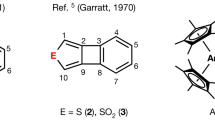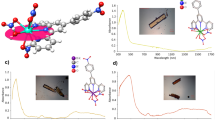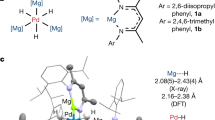Abstract
SEVERAL bivalent metals (nickel, palladium, platinum, copper and silver) are known to exhibit a planar distribution of valencies in their quadri-covalent co-ordination compounds. On the other hand, it has been shown that, in certain derivatives of quadrivalent platinum and univalent copper and silver1, the four valencies of the metal atom have a tetrahedral arrangement, so that it appears highly probable that the bond distribution of quadri-covalent metals is determined by their principal valency. We have now examined some derivatives of bivalent tin and lead, and find, in agreement with this view, that they are planar. It is well known that quadrivalent tin and lead, like carbon, silicon and germanium show a tetrahedral disposition of valencies ; quadrivalent tin is of particular interest, since it furnished one of the first examples2 of optical activity due to an asymmetric atom other than carbon.
This is a preview of subscription content, access via your institution
Access options
Subscribe to this journal
Receive 51 print issues and online access
$199.00 per year
only $3.90 per issue
Buy this article
- Purchase on Springer Link
- Instant access to full article PDF
Prices may be subject to local taxes which are calculated during checkout
Similar content being viewed by others
References
Cox, Wardlaw and Webster, J. Chem. Soc., 775 (1936); Mann, Purdie and Wells, J. Chem. Soc., 1503 (1936).
Pope and Peachey, Proc. Chem. Soc., 42, 116 (1900).
Author information
Authors and Affiliations
Rights and permissions
About this article
Cite this article
Cox, E., SHORTER, A. & WARDLAW, W. Stereochemistry of Bivalent Tin and Lead. Nature 139, 71–72 (1937). https://doi.org/10.1038/139071c0
Issue Date:
DOI: https://doi.org/10.1038/139071c0
This article is cited by
-
Crystal and molecular structure of lead(II) pivalyl trifluoroacetonate
Journal of Structural Chemistry (1994)
-
Structure of the SnCl4- Group
Nature (1939)
Comments
By submitting a comment you agree to abide by our Terms and Community Guidelines. If you find something abusive or that does not comply with our terms or guidelines please flag it as inappropriate.



